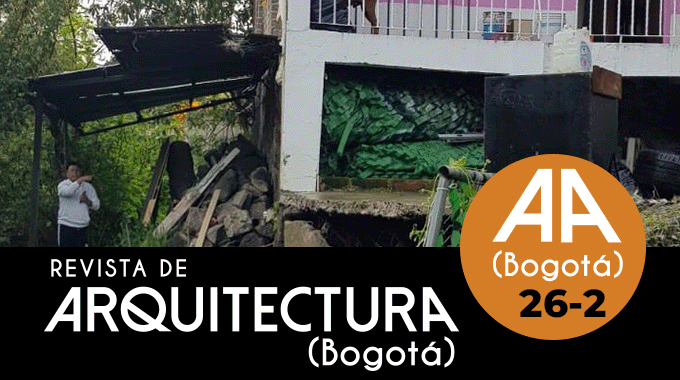

Esta obra está bajo una licencia internacional Creative Commons Atribución-NoComercial 4.0.
La Revista de Arquitectura se cataloga como una publicación de acceso abierto. Más información >>>
Los autores conservarán los derechos de autor y garantizarán a la Revista de Arquitectura el derecho de primera publicación de la obra, el cual estará simultáneamente sujeto a la licencia Creative Commons (CC) BY-NC.
Los autores suscribirán una licencia no exclusiva de distribución de la versión de la obra publicada mediante la firma de (RevArq FP03 Autorización reproducción)
El Autoarchivo estará de acuerdo con los criterios expresados por SHERPA/RoMEO y la clasificación Verde.
Para ver en detalle estos lineamientos, por favor consultar >>>
Resumen
Diversos deslizamientos de tierra afectan viviendas a lo largo de la Ciudad de México (CDMX), por lo cual la resiliencia urbana es muy importante para adaptarse a dichas adversidades de manera momentánea, con el objetivo de que a corto plazo se establezcan medidas de protección civil. El punto central en el presente análisis es la adaptación de personas por medio de resiliencia urbana y la solución breve ante algún riesgo ocurrido; sin embargo, la atención preventiva del gobierno con la población es la que establece realmente el resguardo y cuidado real en los habitantes. A manera de ejemplo, se eligió como zona de estudio la colonia Las Águilas perteneciente a la Alcaldía Álvaro Obregón, donde aconteció un deslizamiento de tierra, mismo que afectó una vivienda parcialmente. Por lo anterior, se generó un modelo preventivo por medio de álgebra de mapas, elaborado con Sistemas de Información Geográfica (SIG), el cual revela el grado de erosividad y posible afectación con base en las características geográficas del suelo. Los resultados cartográficos revelaron diversos niveles de riesgo, mismos que podrán implementarse en dicha zona de estudio por medio de reestructuración urbana y reubicación consensuada, visualizándose que la resiliencia urbana no es el único camino por ejecutar; por el contrario, es solo un momento que deberá tomarse en cuenta para establecer protección en la población, replicándose a futuro en otras partes de México e inclusive en otros países de América Latina donde acontezca dicha problemática.
Palabras clave

Citas
Aceves-Quesada, J., Legorreta-Paulín, G., Lugo-Hubp, J., Umaña-Romero, J., & Legorreta-Cuevas, H. (2016). Sistemas de información geográfica y cartografía geomorfológica aplicados al inventario de deslizamientos y cartografía de susceptibilidad en la cuenca del río El Estado, Pico de Orizaba, México. Investigaciones geográficas, (91), 43-55. http://www.investigacionesgeograficas.unam.mx/index.php/rig/article/view/46503
Administración Nacional de Aeronáutica y el Espacio (NASA). (2022). Earth Data. https://search.asf.alaska.edu/#/
ArcGis. (2016). ¿Qué son los datos ráster? Esri ArcMap. https://desktop.arcgis.com/es/arcmap/10.3/manage-data/raster-and-images/what-is-raster-data.htm
Arner-Reyes, E. (2013). Resiliencia urbana: La adaptación a corto plazo para la recuperación a largo plazo después de las inundaciones en Canadá. Ciencia en su PC, (1),52-65. https://www.redalyc.org/articulo.oa?id=181326400005
Cortés-Ortiz, M., Hernández-Santana, J., & Aguilar-Martínez, A. (2021). Susceptibilidad a procesos de remoción en masa: Aproximación metodológica para la construcción de un índice de amenaza en Álvaro Obregón-Ciudad de México. Entorno Geográfico, (21), 47-76. https://doi.org/10.25100/eg.v0i21.11291
Díaz-Rivera, J., Pérez-Costa, D., Rodríguez-Álvarez, Y., & Febles-González, J. (2008). Determinación de índices de erosión de suelos aplicando análisis SIG para la localidad de San Andrés en la provincia de Pinar del Río. Revista Chapingo, 14(1), 15-19. http://www.scielo.org.mx/scielo.php?script=sci_arttext&pid=S2007-40182008000100003&lng=es&tlng=es.
Duque-Gutiérrez, M., & Quintero-Olaya, J. (2013). La gestión integral del riesgo en territorios urbanos. Nova, 11(20), 121-127. http://www.scielo.org.co/scielo.php?script=sci_arttext&pid=S1794-24702013000200012&lng=en&tlng=es.
García-Vesga, M. & Domínguez-de la Ossa, E. (2013). Desarrollo teórico de la resiliencia y su aplicación en situaciones adversas: Una revisión analítica. Revista Latinoamericana de Ciencias Sociales, Niñez y Juventud, 11(1), 63-77. http://www.scielo.org.co/scielo.php?script=sci_arttext&pid=S1692-715X2013000100003&lng=en&tlng=es.
Gómez-Colorado, O., Horfán-Álvarez, D., & Londoño-Ciro, L. (2018). Análisis multicriterio SIG basado en momentos de orden superior normalizados para el cálculo de superficies de viabilidad ambiental. Ingenierías USBMed, 9(1), 49-57. https://doi.org/10.21500/20275846.3300
Metzger, P., & Robert, J. (2013). Elementos de reflexión sobre la resiliencia urbana: usos criticables y aportes potenciales. Territorios, 28, 21-40. https://revistas.urosario.edu.co/index.php/territorios/article/view/2550
Mora, R. (2014). Contribución del laboratorio de geomecánica de la ECG-UCR al estudio de los deslizamientos en Costa Rica: los últimos 25 años. Revista Geológica De América Central, 1(número especial), 39-44. https://doi.org/10.15517/rgac.v0i0.16548
Pacheco-Moreno, S., & Lewis-Concepción, A. (2007). Los deslizamientos progresivos como grandes destructores ambientales. Universidad, Ciencia y Tecnología, 11(42), 033-037. http://ve.scielo.org/scielo.php?script=sci_arttext&pid=S1316-48212007000100006&lng=es&tlng=es
Pacha, J., & Villamarín, G. (2018). Resiliencia urbana en ciudades intermedias de América Latina. Medio Ambiente y Urbanización, 88(1),11-28. https://www.ingentaconnect.com/contentone/iieal/meda/2018/00000088/00000001/art00002#
Páez, L., & Ornes, S. (2019). La resiliencia urbana: ¿Condición, proceso o fin? Reflexión para avanzar en la gestión integral de riesgo de desastres en ciudades. Tekhné, 22(3). https://revistasenlinea.saber.ucab.edu.ve/index.php/tekhne/article/view/4460
Portal Atlas de Riesgos de la CDMX. (2022). Atlas de Riesgos de la CDMX. https://www.atlas.cdmx.gob.mx/analisisn2/
Rivera-González, O. (2022). Inestabilidad de laderas y metodología para la reparación del daño y concientización, Santo Tomás Chautla, Puebla, México. Revista Científica GeoLatitud, 5(1), 44-54. https://geolatitud.geoenergia.gob.ec/ojs/ojs/index.php/GeoLatitud/article/view/117/102
Suárez, J. (1998). Deslizamientos y estabilidad de taludes en zonas tropicales. Instituto de Investigaciones sobre Erosión y Deslizamientos. https://desastres.medicina.usac.edu.gt/documentos/docgt/pdf/spa/doc0101/doc0101.pdf
Suárez-Lastra, M., & Delgado-Campos, J. (2007). La expansión urbana probable de la Ciudad de México. Un escenario pesimista y dos alternativos para el año 2020. Estudios Demográficos y Urbanos, 22(1), 101-142. https://estudiosdemograficosyurbanos.colmex.mx/index.php/edu/article/view/1295
Trejo, Y. (2021, 03 de octubre). Desalojan a 13 personas por deslave en alcaldía Álvaro Obregón. Periódico AS. https://mexico.as.com/mexico/2021/10/04/actualidad/1633307689_586118.html
































